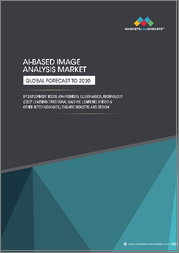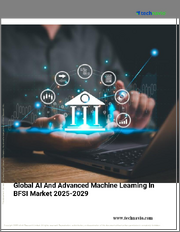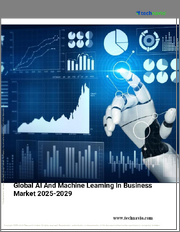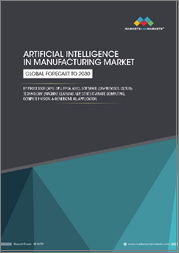
|
시장보고서
상품코드
1593919
MLaaS(Machine-Learning-as-a-Service) 시장 : 구성요소, 용도, 최종 사용자별 - 세계 예측(2025-2030년)Machine-Learning-as-a-Service Market by Component (Services, Software), Application (Augmented & Virtual Reality, Fraud Detection & Risk Management, Marketing & Advertising), End User - Global Forecast 2025-2030 |
||||||
MLaaS(Machine-Learning-as-a-Service) 시장은 2023년에 214억 8,000만 달러로 평가되었습니다. 2024년에는 280억 달러에 이를 것으로 예측되며, CAGR 30.40%로 성장하여 2030년에는 1,377억 8,000만 달러에 달할 것으로 예측됩니다.
Machine-Learning-as-a-Service(MLaaS)는 데이터 과학에 대한 심층적인 전문 지식이나 대규모 인프라 투자 없이도 종합적인 머신러닝 도구, 기술 및 용도를 기업에 제공하는 클라우드 기반 플랫폼을 말합니다. 이 서비스는 고급 분석에 대한 접근을 민주화하고 다양한 산업에서 빅데이터 분석, 예측 분석 및 복잡한 의사결정 과정에 고급 알고리즘을 활용할 수 있도록 하는 데 필수적입니다. 헬스케어, 금융, 소매, 제조 등 다양한 분야에 걸쳐 부정행위 감지, 개인화된 마케팅, 고객 인사이트, 업무 효율성 향상 등의 기능을 촉진합니다. 최종 사용 범위에는 AI를 워크플로우에 원활하게 통합하여 혁신적인 제품 및 서비스 시장 출시 시간을 단축하고자 하는 기업도 포함됩니다.
| 주요 시장 통계 | |
|---|---|
| 기준 연도(2023년) | 214억 8,000만 달러 |
| 예측 연도(2024년) | 280억 달러 |
| 예측 연도(2030년) | 1,377억 8,000만 달러 |
| CAGR(%) | 30.40% |
MLaaS 시장의 주요 성장 요인으로는 데이터 확산 증가, 클라우드 도입 촉진, AI 기반 솔루션에 대한 수요 증가 등이 있습니다. 기업들은 데이터 중심의 고민을 통해 경쟁 우위를 확보하고자 노력하고 있으며, 이는 MLaaS 플랫폼에 대한 수요를 촉진하고 있습니다. 특히, 산업별 특성에 맞는 틈새 솔루션 개발, 모델 설명 가능성 향상, 프라이버시 보호 강화 등의 과제가 있습니다. 기업들은 강력한 사이버 보안 조치에 투자하고, 신흥 시장 공략을 위해 다국어 지원을 확대하는 것이 도움이 될 수 있습니다.
성장을 저해하는 요인으로는 데이터 프라이버시에 대한 우려, 규제 문제, 복잡한 결과물을 해석할 수 있는 숙련된 전문가 부족 등을 들 수 있습니다. 또한, MLaaS 솔루션은 기존 인프라와의 통합에 어려움을 겪는 경우가 많습니다. 이를 극복하기 위해 기업은 IT 컨설팅 회사와의 제휴를 통해 보다 쉬운 통합 메커니즘을 갖춘 사용자 친화적인 플랫폼 개발에 집중해야 합니다.
혁신은 자동 머신러닝(AutoML), 엣지 컴퓨팅의 통합, 신뢰 구축 및 규제 준수를 용이하게 하는 모델의 투명성 강화에 대한 연구를 통해 촉진될 수 있습니다. 또한, 학계와 산업계의 협업을 촉진함으로써 특정 용도에 적합한 새로운 알고리즘을 개발할 수 있을 것으로 보입니다. 급속한 기술 발전과 소비자 수요 패턴의 변화 등 시장의 특성은 여전히 역동적입니다. 이러한 요인을 전략적으로 탐색하고 지속적인 학습과 적응성을 우선시함으로써 기업은 MLaaS의 잠재력을 최대한 활용하고 빠르게 성장하는 시장에서 발판을 마련할 수 있습니다.
시장 역학: 빠르게 진화하는 MLaaS(Machine-Learning-as-a-Service) 시장의 주요 시장 인사이트를 공개합니다.
MLaaS(Machine-Learning-as-a-Service) 시장은 수요 및 공급의 역동적인 상호작용을 통해 변화하고 있습니다. 이러한 시장 역학의 변화를 이해함으로써 기업은 정보에 입각한 투자 결정을 내리고, 전략적인 의사결정을 정교화하며, 새로운 비즈니스 기회를 포착할 수 있습니다. 이러한 트렌드를 종합적으로 파악함으로써 기업은 정치적, 지리적, 기술적, 사회적, 경제적 영역 전반에 걸친 다양한 리스크를 줄일 수 있으며, 소비자 행동과 그것이 제조 비용 및 구매 동향에 미치는 영향을 보다 명확하게 이해할 수 있습니다.
- 시장 성장 촉진요인
- IoT 및 자동화 도입 증가
- 클라우드 기반 서비스 이용 확대
- 다양한 산업 분야의 성능 및 업무 효율성 개선 필요
- 시장 성장 억제요인
- 훈련을 받은 전문가 부족
- 시장 기회
- 인지 컴퓨팅, 신경망, 딥러닝 기술, 인공지능(AI)의 통합으로 인한 기술 발전
- 헬스케어 산업에서의 투자 및 협업 확대
- 시장 과제
- 데이터 보안 및 개인정보 보호에 대한 우려
Portre's Five Forces: MLaaS(Machine-Learning-as-a-Service) 시장 공략을 위한 전략적 도구
Portre's Five Forces 프레임워크는 시장 상황경쟁 구도를 이해하는 중요한 도구입니다. Portre's Five Forces 프레임워크는 기업의 경쟁력을 평가하고 전략적 기회를 탐색할 수 있는 명확한 방법을 제공합니다. 이 프레임워크는 기업이 시장 내 세력도를 평가하고 신규 사업의 수익성을 판단하는 데 도움이 됩니다. 이러한 통찰력을 통해 기업은 강점을 활용하고, 약점을 해결하고, 잠재적인 도전을 피하고, 보다 강력한 시장 포지셔닝을 확보할 수 있습니다.
PESTLE 분석 : MLaaS(Machine-Learning-as-a-Service) 시장의 외부 영향력 파악
외부 거시 환경 요인은 MLaaS(Machine-Learning-as-a-Service) 시장의 성과 역학을 형성하는 데 매우 중요한 역할을 합니다. 정치적, 경제적, 사회적, 기술적, 법적, 환경적 요인에 대한 분석은 이러한 영향을 탐색하는 데 필요한 정보를 제공하며, PESTLE 요인을 조사함으로써 기업은 잠재적인 위험과 기회를 더 잘 이해할 수 있습니다. 이러한 분석을 통해 기업은 규제, 소비자 선호도, 경제 동향의 변화를 예측하고 선제적이고 능동적인 의사결정을 내릴 준비를 할 수 있습니다.
시장 점유율 분석MLaaS(Machine-Learning-as-a-Service) 시장에서경쟁 구도 파악
MLaaS(Machine-Learning-as-a-Service) 시장의 상세한 시장 점유율 분석을 통해 벤더의 성과를 종합적으로 평가할 수 있습니다. 기업은 수익, 고객 기반, 성장률과 같은 주요 지표를 비교하여 경쟁적 위치를 파악할 수 있습니다. 이 분석은 시장의 집중화, 단편화 및 통합 추세를 파악할 수 있으며, 공급업체는 치열한 경쟁 속에서 자신의 입지를 강화할 수 있는 전략적 의사결정을 내리는 데 필요한 통찰력을 얻을 수 있습니다.
FPNV 포지셔닝 매트릭스 MLaaS(Machine-Learning-as-a-Service) 시장에서의 벤더의 성과 평가
FPNV 포지셔닝 매트릭스는 MLaaS(Machine-Learning-as-a-Service) 시장에서 벤더를 평가할 수 있는 중요한 도구입니다. 이 매트릭스를 통해 비즈니스 조직은 벤더의 비즈니스 전략과 제품 만족도를 기반으로 평가하여 목표에 부합하는 정보에 입각한 의사결정을 내릴 수 있으며, 4개의 사분면으로 벤더를 명확하고 정확하게 세분화하여 전략 목표에 가장 적합한 파트너와 솔루션을 식별할 수 있습니다. 전략 목표에 가장 적합한 파트너와 솔루션을 식별할 수 있습니다.
MLaaS(Machine-Learning-as-a-Service) 시장에서 성공하기 위한 전략 분석 및 추천 머신러닝 시장 성공의 길을 그리다.
MLaaS(Machine-Learning-as-a-Service) 시장 전략 분석은 세계 시장에서 입지를 강화하고자 하는 기업에게 필수적입니다. 주요 자원, 역량 및 성과 지표를 검토함으로써 기업은 성장 기회를 파악하고 개선할 수 있습니다. 이러한 접근 방식은 경쟁 환경의 도전을 극복하고 새로운 비즈니스 기회를 활용하여 장기적인 성공을 거둘 수 있는 체계를 구축할 수 있도록 도와줍니다.
이 보고서는 주요 관심 분야를 포괄하는 시장에 대한 종합적인 분석을 제공합니다.
1. 시장 침투도 : 현재 시장 환경의 상세한 검토, 주요 기업의 광범위한 데이터, 시장 도달 범위 및 전반적인 영향력 평가.
2. 시장 개척도: 신흥 시장에서의 성장 기회를 파악하고, 기존 분야의 확장 가능성을 평가하며, 미래 성장을 위한 전략적 로드맵을 제공합니다.
3. 시장 다각화 : 최근 제품 출시, 미개척 지역, 업계의 주요 발전, 시장을 형성하는 전략적 투자를 분석합니다.
4. 경쟁 평가 및 정보 : 경쟁 구도를 철저히 분석하여 시장 점유율, 사업 전략, 제품 포트폴리오, 인증, 규제 당국의 승인, 특허 동향, 주요 기업의 기술 발전 등을 검토합니다.
5. 제품 개발 및 혁신 : 미래 시장 성장을 가속할 것으로 예상되는 첨단 기술, 연구 개발 활동 및 제품 혁신을 강조합니다.
이해관계자들이 충분한 정보를 바탕으로 의사결정을 내릴 수 있도록 다음과 같은 중요한 질문에 대한 답변도 제공합니다.
1. 현재 시장 규모와 향후 성장 전망은?
2. 최고의 투자 기회를 제공하는 제품, 부문, 지역은?
3. 시장을 형성하는 주요 기술 동향과 규제의 영향은?
4. 주요 벤더의 시장 점유율과 경쟁 포지션은?
5.벤더 시장 진입 및 철수 전략의 원동력이 되는 수익원과 전략적 기회는 무엇인가?
목차
제1장 서문
제2장 조사 방법
제3장 주요 요약
제4장 시장 개요
제5장 시장 인사이트
- 시장 역학
- 성장 촉진요인
- 성장 억제요인
- 기회
- 과제
- 시장 세분화 분석
- Porter의 Five Forces 분석
- PESTEL 분석
- 정치
- 경제
- 사회
- 기술
- 법률
- 환경
제6장 MLaaS(Machine-Learning-as-a-Service) 시장 : 컴포넌트별
- 서비스
- 소프트웨어
제7장 MLaaS(Machine-Learning-as-a-Service) 시장 : 용도별
- 증강현실(AR) 및 가상현실(VR)
- 부정 감지 및 리스크 관리
- 마케팅 및 광고
- 예측 분석
- 보안 및 감시
제8장 MLaaS(Machine-Learning-as-a-Service) 시장 : 최종사용자별
- 은행/금융서비스/보험(BFSI)
- 헬스케어 및 생명과학
- 제조업
- 소매
- 통신
제9장 아메리카의 MLaaS(Machine-Learning-as-a-Service) 시장
- 아르헨티나
- 브라질
- 캐나다
- 멕시코
- 미국
제10장 아시아태평양의 MLaaS(Machine-Learning-as-a-Service) 시장
- 호주
- 중국
- 인도
- 인도네시아
- 일본
- 말레이시아
- 필리핀
- 싱가포르
- 한국
- 대만
- 태국
- 베트남
제11장 유럽, 중동 및 아프리카의 MLaaS(Machine-Learning-as-a-Service) 시장
- 덴마크
- 이집트
- 핀란드
- 프랑스
- 독일
- 이스라엘
- 이탈리아
- 네덜란드
- 나이지리아
- 노르웨이
- 폴란드
- 카타르
- 러시아
- 사우디아라비아
- 남아프리카공화국
- 스페인
- 스웨덴
- 스위스
- 터키
- 아랍에미리트(UAE)
- 영국
제12장 경쟁 구도
- 시장 점유율 분석 2023
- FPNV 포지셔닝 매트릭스, 2023
- 경쟁 시나리오 분석
- 전략 분석과 제안
기업 리스트
- Amazon.com Inc.
- AT&T Inc.
- BigML, Inc.
- Fair Isaac Corporation
- Google LLC
- H2O.ai
- Hewlett Packard Enterprise Company
- IBM Corp.
- Iflowsoft Solutions Inc.
- Microsoft Corporation
- Monkeylearn Inc.
- SAS Institute Inc.
- Sift Science Inc.
- Yottamine Analytics, LLC
The Machine-Learning-as-a-Service Market was valued at USD 21.48 billion in 2023, expected to reach USD 28.00 billion in 2024, and is projected to grow at a CAGR of 30.40%, to USD 137.78 billion by 2030.
Machine-Learning-as-a-Service (MLaaS) refers to a cloud-based platform offering comprehensive machine learning tools, techniques, and applications for businesses without requiring in-depth expertise in data science or extensive infrastructure investment. This service is essential for democratizing access to advanced analytics, enabling various industries to leverage sophisticated algorithms for big data analysis, predictive analytics, and complex decision-making processes. Its application spans across sectors such as healthcare, finance, retail, and manufacturing, facilitating functions like fraud detection, personalized marketing, customer insights, and operational efficiency enhancement. The end-use scope includes companies seeking to integrate AI into their workflow seamlessly, reducing time-to-market for innovative products and services.
| KEY MARKET STATISTICS | |
|---|---|
| Base Year [2023] | USD 21.48 billion |
| Estimated Year [2024] | USD 28.00 billion |
| Forecast Year [2030] | USD 137.78 billion |
| CAGR (%) | 30.40% |
Key growth factors for the MLaaS market include increasing data proliferation, a push towards cloud adoption, and rising demand for AI-driven solutions. Organizations are striving for competitive advantages through data-driven insights, which is propelling demand for MLaaS platforms. Opportunities exist particularly in developing niche solutions tailored to industry-specific challenges, improving model explainability, and enhancing privacy protections. Companies can benefit by investing in robust cybersecurity measures and expanding multi-language support to capture emerging markets.
Limitations hindering growth include concerns over data privacy, regulatory challenges, and a shortage of skilled professionals to interpret complex outputs. Additionally, MLaaS solutions often face integration challenges with existing infrastructure. To overcome these, companies should focus on developing user-friendly platforms with easier integration mechanisms, possibly through partnerships with IT consultancies.
Innovation can be spurred through research in automated machine learning (AutoML), edge computing integration, and enhanced model transparency which can build trust and ease regulatory compliance. Moreover, fostering collaborations between academia and industry could yield novel algorithms suited for specific applications. The nature of the market remains dynamic, with rapid technological advancements and shifts in consumer demand patterns. By strategically navigating these factors and prioritizing continual learning and adaptability, businesses can harness MLaaS's full potential and secure their foothold in this burgeoning market.
Market Dynamics: Unveiling Key Market Insights in the Rapidly Evolving Machine-Learning-as-a-Service Market
The Machine-Learning-as-a-Service Market is undergoing transformative changes driven by a dynamic interplay of supply and demand factors. Understanding these evolving market dynamics prepares business organizations to make informed investment decisions, refine strategic decisions, and seize new opportunities. By gaining a comprehensive view of these trends, business organizations can mitigate various risks across political, geographic, technical, social, and economic domains while also gaining a clearer understanding of consumer behavior and its impact on manufacturing costs and purchasing trends.
- Market Drivers
- Rising adoption of IoT and automation
- Growing usage of cloud-based services
- Need to improve performance and operational efficiency in the several industry
- Market Restraints
- Lack of trained professionals
- Market Opportunities
- Advancements in technologies with the integration of cognitive computing, neural networks, deep learning technologies, and artificial intelligence (AI)
- Growing investments and collaboration in the healthcare Industry
- Market Challenges
- Data security and privacy concerns
Porter's Five Forces: A Strategic Tool for Navigating the Machine-Learning-as-a-Service Market
Porter's five forces framework is a critical tool for understanding the competitive landscape of the Machine-Learning-as-a-Service Market. It offers business organizations with a clear methodology for evaluating their competitive positioning and exploring strategic opportunities. This framework helps businesses assess the power dynamics within the market and determine the profitability of new ventures. With these insights, business organizations can leverage their strengths, address weaknesses, and avoid potential challenges, ensuring a more resilient market positioning.
PESTLE Analysis: Navigating External Influences in the Machine-Learning-as-a-Service Market
External macro-environmental factors play a pivotal role in shaping the performance dynamics of the Machine-Learning-as-a-Service Market. Political, Economic, Social, Technological, Legal, and Environmental factors analysis provides the necessary information to navigate these influences. By examining PESTLE factors, businesses can better understand potential risks and opportunities. This analysis enables business organizations to anticipate changes in regulations, consumer preferences, and economic trends, ensuring they are prepared to make proactive, forward-thinking decisions.
Market Share Analysis: Understanding the Competitive Landscape in the Machine-Learning-as-a-Service Market
A detailed market share analysis in the Machine-Learning-as-a-Service Market provides a comprehensive assessment of vendors' performance. Companies can identify their competitive positioning by comparing key metrics, including revenue, customer base, and growth rates. This analysis highlights market concentration, fragmentation, and trends in consolidation, offering vendors the insights required to make strategic decisions that enhance their position in an increasingly competitive landscape.
FPNV Positioning Matrix: Evaluating Vendors' Performance in the Machine-Learning-as-a-Service Market
The Forefront, Pathfinder, Niche, Vital (FPNV) Positioning Matrix is a critical tool for evaluating vendors within the Machine-Learning-as-a-Service Market. This matrix enables business organizations to make well-informed decisions that align with their goals by assessing vendors based on their business strategy and product satisfaction. The four quadrants provide a clear and precise segmentation of vendors, helping users identify the right partners and solutions that best fit their strategic objectives.
Strategy Analysis & Recommendation: Charting a Path to Success in the Machine-Learning-as-a-Service Market
A strategic analysis of the Machine-Learning-as-a-Service Market is essential for businesses looking to strengthen their global market presence. By reviewing key resources, capabilities, and performance indicators, business organizations can identify growth opportunities and work toward improvement. This approach helps businesses navigate challenges in the competitive landscape and ensures they are well-positioned to capitalize on newer opportunities and drive long-term success.
Key Company Profiles
The report delves into recent significant developments in the Machine-Learning-as-a-Service Market, highlighting leading vendors and their innovative profiles. These include Amazon.com Inc., AT&T Inc., BigML, Inc., Fair Isaac Corporation, Google LLC, H2O.ai, Hewlett Packard Enterprise Company, IBM Corp., Iflowsoft Solutions Inc., Microsoft Corporation, Monkeylearn Inc., SAS Institute Inc., Sift Science Inc., and Yottamine Analytics, LLC.
Market Segmentation & Coverage
This research report categorizes the Machine-Learning-as-a-Service Market to forecast the revenues and analyze trends in each of the following sub-markets:
- Based on Component, market is studied across Services and Software.
- Based on Application, market is studied across Augmented & Virtual Reality, Fraud Detection & Risk Management, Marketing & Advertising, Predictive Analytics, and Security & Surveillance.
- Based on End User, market is studied across BFSI, Healthcare & Life Sciences, Manufacturing, Retail, and Telecom.
- Based on Region, market is studied across Americas, Asia-Pacific, and Europe, Middle East & Africa. The Americas is further studied across Argentina, Brazil, Canada, Mexico, and United States. The United States is further studied across California, Florida, Illinois, New York, Ohio, Pennsylvania, and Texas. The Asia-Pacific is further studied across Australia, China, India, Indonesia, Japan, Malaysia, Philippines, Singapore, South Korea, Taiwan, Thailand, and Vietnam. The Europe, Middle East & Africa is further studied across Denmark, Egypt, Finland, France, Germany, Israel, Italy, Netherlands, Nigeria, Norway, Poland, Qatar, Russia, Saudi Arabia, South Africa, Spain, Sweden, Switzerland, Turkey, United Arab Emirates, and United Kingdom.
The report offers a comprehensive analysis of the market, covering key focus areas:
1. Market Penetration: A detailed review of the current market environment, including extensive data from top industry players, evaluating their market reach and overall influence.
2. Market Development: Identifies growth opportunities in emerging markets and assesses expansion potential in established sectors, providing a strategic roadmap for future growth.
3. Market Diversification: Analyzes recent product launches, untapped geographic regions, major industry advancements, and strategic investments reshaping the market.
4. Competitive Assessment & Intelligence: Provides a thorough analysis of the competitive landscape, examining market share, business strategies, product portfolios, certifications, regulatory approvals, patent trends, and technological advancements of key players.
5. Product Development & Innovation: Highlights cutting-edge technologies, R&D activities, and product innovations expected to drive future market growth.
The report also answers critical questions to aid stakeholders in making informed decisions:
1. What is the current market size, and what is the forecasted growth?
2. Which products, segments, and regions offer the best investment opportunities?
3. What are the key technology trends and regulatory influences shaping the market?
4. How do leading vendors rank in terms of market share and competitive positioning?
5. What revenue sources and strategic opportunities drive vendors' market entry or exit strategies?
Table of Contents
1. Preface
- 1.1. Objectives of the Study
- 1.2. Market Segmentation & Coverage
- 1.3. Years Considered for the Study
- 1.4. Currency & Pricing
- 1.5. Language
- 1.6. Stakeholders
2. Research Methodology
- 2.1. Define: Research Objective
- 2.2. Determine: Research Design
- 2.3. Prepare: Research Instrument
- 2.4. Collect: Data Source
- 2.5. Analyze: Data Interpretation
- 2.6. Formulate: Data Verification
- 2.7. Publish: Research Report
- 2.8. Repeat: Report Update
3. Executive Summary
4. Market Overview
5. Market Insights
- 5.1. Market Dynamics
- 5.1.1. Drivers
- 5.1.1.1. Rising adoption of IoT and automation
- 5.1.1.2. Growing usage of cloud-based services
- 5.1.1.3. Need to improve performance and operational efficiency in the several industry
- 5.1.2. Restraints
- 5.1.2.1. Lack of trained professionals
- 5.1.3. Opportunities
- 5.1.3.1. Advancements in technologies with the integration of cognitive computing, neural networks, deep learning technologies, and artificial intelligence (AI)
- 5.1.3.2. Growing investments and collaboration in the healthcare Industry
- 5.1.4. Challenges
- 5.1.4.1. Data security and privacy concerns
- 5.1.1. Drivers
- 5.2. Market Segmentation Analysis
- 5.3. Porter's Five Forces Analysis
- 5.3.1. Threat of New Entrants
- 5.3.2. Threat of Substitutes
- 5.3.3. Bargaining Power of Customers
- 5.3.4. Bargaining Power of Suppliers
- 5.3.5. Industry Rivalry
- 5.4. PESTLE Analysis
- 5.4.1. Political
- 5.4.2. Economic
- 5.4.3. Social
- 5.4.4. Technological
- 5.4.5. Legal
- 5.4.6. Environmental
6. Machine-Learning-as-a-Service Market, by Component
- 6.1. Introduction
- 6.2. Services
- 6.3. Software
7. Machine-Learning-as-a-Service Market, by Application
- 7.1. Introduction
- 7.2. Augmented & Virtual Reality
- 7.3. Fraud Detection & Risk Management
- 7.4. Marketing & Advertising
- 7.5. Predictive Analytics
- 7.6. Security & Surveillance
8. Machine-Learning-as-a-Service Market, by End User
- 8.1. Introduction
- 8.2. BFSI
- 8.3. Healthcare & Life Sciences
- 8.4. Manufacturing
- 8.5. Retail
- 8.6. Telecom
9. Americas Machine-Learning-as-a-Service Market
- 9.1. Introduction
- 9.2. Argentina
- 9.3. Brazil
- 9.4. Canada
- 9.5. Mexico
- 9.6. United States
10. Asia-Pacific Machine-Learning-as-a-Service Market
- 10.1. Introduction
- 10.2. Australia
- 10.3. China
- 10.4. India
- 10.5. Indonesia
- 10.6. Japan
- 10.7. Malaysia
- 10.8. Philippines
- 10.9. Singapore
- 10.10. South Korea
- 10.11. Taiwan
- 10.12. Thailand
- 10.13. Vietnam
11. Europe, Middle East & Africa Machine-Learning-as-a-Service Market
- 11.1. Introduction
- 11.2. Denmark
- 11.3. Egypt
- 11.4. Finland
- 11.5. France
- 11.6. Germany
- 11.7. Israel
- 11.8. Italy
- 11.9. Netherlands
- 11.10. Nigeria
- 11.11. Norway
- 11.12. Poland
- 11.13. Qatar
- 11.14. Russia
- 11.15. Saudi Arabia
- 11.16. South Africa
- 11.17. Spain
- 11.18. Sweden
- 11.19. Switzerland
- 11.20. Turkey
- 11.21. United Arab Emirates
- 11.22. United Kingdom
12. Competitive Landscape
- 12.1. Market Share Analysis, 2023
- 12.2. FPNV Positioning Matrix, 2023
- 12.3. Competitive Scenario Analysis
- 12.4. Strategy Analysis & Recommendation
Companies Mentioned
- 1. Amazon.com Inc.
- 2. AT&T Inc.
- 3. BigML, Inc.
- 4. Fair Isaac Corporation
- 5. Google LLC
- 6. H2O.ai
- 7. Hewlett Packard Enterprise Company
- 8. IBM Corp.
- 9. Iflowsoft Solutions Inc.
- 10. Microsoft Corporation
- 11. Monkeylearn Inc.
- 12. SAS Institute Inc.
- 13. Sift Science Inc.
- 14. Yottamine Analytics, LLC



















